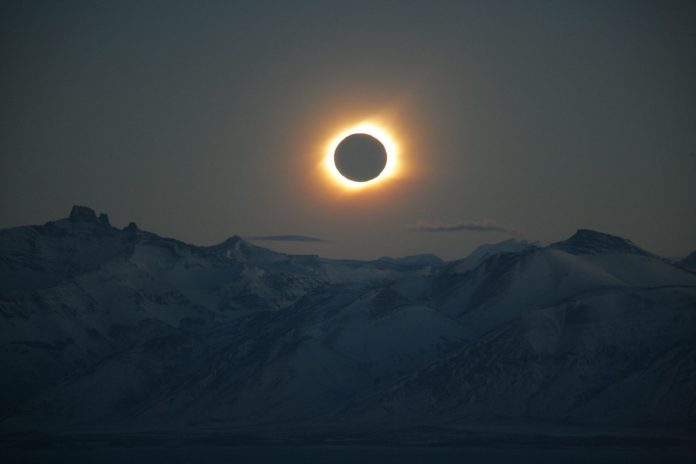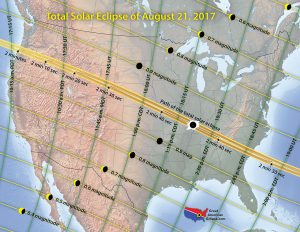
Obviously the solar eclipse of August 21, 2017, occurs on August 21, 2017! That’s a Monday — in many places, the first day of the new school year.
It takes about 90 minutes for the Moon’s dark shadow to cross the country, starting around 10:15 am Pacific time on the West Coast and ending around 2:45 pm Eastern time (11:45 am Pacific time) on the East Coast. When you hear someone say, “the total eclipse lasts 90 minutes,” that’s what they mean. But that could be misleading: At any given location within the path of the Moon’s shadow, the total eclipse lasts at most 2 minutes 40 seconds — don’t be late!
The Moon takes its first “bite” out of the Sun, marking the start of the partial eclipse, 1¼ to 1½ hours earlier, around 9:00 am PDT on the West Coast and 1:15 pm EDT on the East Coast. The Moon uncovers the last of the Sun’s bright face 2½ to 3 hours after that, around 11:30 am PDT on the West Coast and 4:15 pm EDT on the East Coast. This marks the end of the partial eclipse.
Here’s a table with times for a handful of U.S. cities and towns in the path of totality, courtesy of NASA:

To find out when the eclipse occurs at any other location (and what it will look like from that location), visit TimeandDate.org.

In order to have a total eclipse of the Sun on August 21, 2017, you must position yourself within the roughly 70-mile-wide track labeled “Path of the total solar eclipse” in the map above. Within the path of totality, weather permitting, you will see one of the most spectacular sights in all of nature: the solar corona — the Sun’s pearly outer atmosphere, which you can look at directly without solar filters or other protective measures. Outside the path of totality, you will see at most a partial solar eclipse, and only if you take special precautions to avoid eye injury.
Everybody is asking, “Where should I go to see the eclipse?” There is no one right answer. Here are several right answers:
- You should make every effort, if possible, to get into the path of totality on August 21, 2017. If you already live within the path, you’re in luck! If not, note that nearly everyone in the continental U.S. lives within a 1- or 2-day drive of the path.
- Totality lasts longer toward the center of the path of the Moon’s shadow than it does near the edge, so the closer you are to the “center line” of the eclipse, the more time you’ll have to enjoy the splendors of totality (weather permitting).
- Being within the path of totality is better than being outside it, but some places within the path may be better than others, depending on your preferences and budget. As described in more detail on our Weather & Climate page, experienced eclipse chasers aim to strike a balance among three factors: duration of totality; local accommodations, amenities, and attractions; and the likelihood of clear skies. These considerations often conflict with each other, for example, totality lasts longer in southern Illinois than it does to the northwest or southeast, but the parts of the country most likely to have clear skies in late August are in the northwest.
- You should have a Plan B in case the weather isn’t looking good on eclipse day at your preferred observing location. It’ll be helpful if there are good roads heading from your Plan A site to the northwest and southeast along the path of totality.
[Source: American Astronomical Society]

